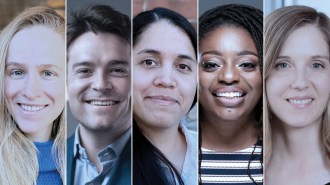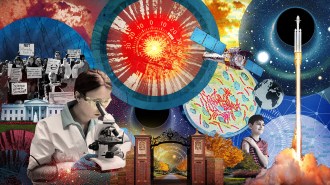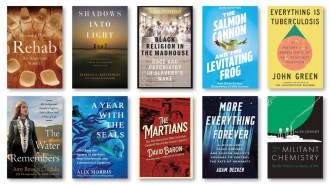Science literacy: U.S. college courses really count
SAN DIEGO – Over the past two decades, science literacy in the United States – an estimate of the share of adults who can follow complex science issues and maybe even render an informed opinion on them – has nearly tripled. But – and it’s a big but — the proportion of people who fall into this category remains small. Just 28 percent.
Jon Miller of Michigan State University reported the numbers at the American Association for the Advancement of Science annual meeting, this afternoon, during a session on civic science literacy assessments around the world.
The new U.S. rate, based on questionnaires administered in 2008, is seven percentage points behind Sweden, the only European nation to exceed the Americans.
The U.S. figure is slightly higher than that for Denmark, Finland, Norway and the Netherlands. And it’s double the 2005 rate in the United Kingdom (and the collective rate for the European Union).
America’s improving science and tech literacy does not appear to reflect better K-12 science education, Miller says, since scores on tests assessing kids’ science literacy has remained fairly stable – and not that high. Indeed, he notes, U.S. high school students “are below average and below most European countries” on virtually every international achievement test administered throughout the past 30 years. One in four American students don’t even complete high school, and among those who do, he contends, many are “poorly educated.” Against this background, he says, one is tempted to ask how science literacy among U.S. adults could have risen to become second only to the Swedes’.
The likely answer, he contends, traces to the U.S. undergraduate curriculum.
“The United States is the only country in the world, right now, that requires all of its university students take a year of general education,” Miller says. “Which means they all have a year of science, a year of social science, and a year of humanities.” It’s something he contends European and other nations would do well to match.
After today’s panel discussion was over, I asked Miller to speculate on what’s so special about college science. After all, most students get high-school science.
In general, high-school science classes tend to be elementary in nature, he says, and poorly taught – often by teachers who lack much grounding in the subject.
“A lot of learning also has to do with expectations,” he maintains. When they’re low, students don’t feel compelled to try hard. But unlike in U.S. high schools, “college courses come with high expectations,” Miller says, and professors insist that you actually do work – or you fail.
Kinya Shimizu of Hiroshima University also reported some increases in science literacy between 1991 and 2001 among randomly polled Japanese adults. In these surveys, results tended to vary with the subject – and sometimes tracked current events.
For instance, 29 percent of the 1,500 to 2,000 adults polled each time knew that electrons were smaller than atoms and about 75 percent each time understood the precepts of evolution. But the share who knew antibiotics won’t kill viruses doubled in 2001 – to 20 percent of adults. And the share of people who knew that all regions in Japan were vulnerable to earthquakes was 80 percent in the second survey, up from 60 percent a decade earlier.
The decade’s large rise in earthquake literacy was understandable, Shimizu said, owing to all of the media coverage that appeared in the aftermath of the 1995 Kobe earthquake, when accounts of plate tectonics filled the news. Having witnessed the devastation to which their islands were vulnerable, people could suddenly relate to this science. And apparently retained much of what they read.
Which begs the question: What about people who can’t relate to modern science? It’s unrealistic to expect an agrarian villager in tribal Amazonian community to know the size of an electron if he has never even heard of an atom, observed physicist Marcelo Knobel of the State University of Campinas in Brazil, who reviewed diverse science literacy rates among Latin American countries, Spain and Portugal.
Yet at some level, it doesn’t matter why people don’t understand science and technical issues. Because regardless of the reason, they’re still at risk of becoming “disenfranchised as citizens” in the modern world. Or so argued Geoffrey Thomas of Kellogg College, Oxford, in Britain. In a democracy, all citizens should be able to weigh in on important or contentious science and technology proposals or policies. For instance, should federal funds be spent on stem cell research, on developing genetically modified organisms or on a nuclear-reprocessing plant? People can’t or won’t responsibly vote on referenda or back petitions if they feel that they can’t follow the particulars being debated in public,
Thomas pointed out.
Miller offered an anecdote to illustrate the problem. In 2003, his team polled adults on a range of issues, including their opinions of stem-cell research. At the time, 17 percent of people backed these studies strongly, citing the promise this research had for fighting neurological diseases and diabetes. An equal number vehemently opposed the research on right-to-life grounds.
Throughout the next year, stem-cell studies emerged as a major theme in presidential debates. When Miller’s team again polled people on stem cells a week before the election, only a quarter as many people (4 percent) now either strongly favored or rejected stem-cell research.
And the other 92 percent? They concluded that the issue was too complex to understand, Miller said, so they just ignored it. But“it’s fundamentally wrong for a democracy to have to take off the table things that are complex,” he says.
And even the newest science literacy numbers for U.S. adults show that vast numbers of people still won’t likely be able to follow a public-policy debate on most science and technology issues, he says.
Perhaps.
Or maybe these people will develop a newfound science literacy in issues that suddenly grab relevancy, said sociologist Jeong-Ro Yoon of the Korea Advanced Institute of Science and Technology in Daejeon. Such as if the nuclear reprocessing plant would be built in their neighborhood, or the GM crops would be test planted upwind of their fields.
Miller conceded that some of the rapid increase in science literacy that he’s been chronicling in American adults may reflect just such a self-education on issues of interest, aided by the Internet. Few people will read a book on cancer biology when they’re healthy, he notes. But as soon as a loved one develops a life-threatening malignancy, parents or spouses often immerse themselves in anything and everything available on the topic.







